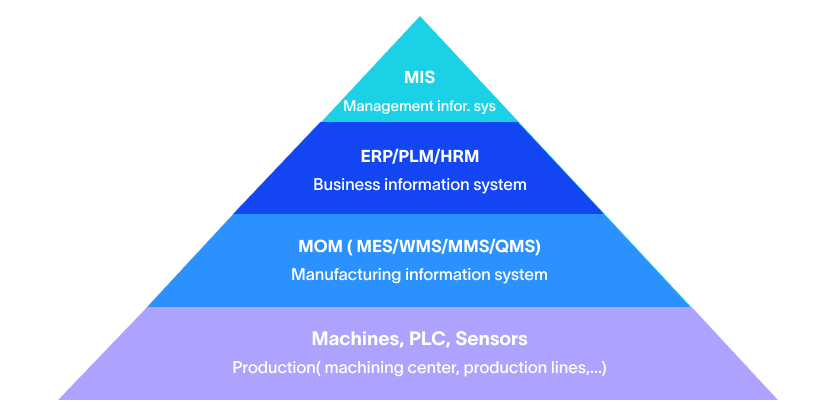Modernization Without Chaos — How to Upgrade Legacy Systems While Running at Full Speed
Blog
5 Min 20 Sec Read
Manufacturing is one of the most vulnerable sectors, with a high number of legacy systems in place. However, a wide range of companies still rely on outdated SCAD systems.
These traditional systems don’t offer advanced security, making your organization susceptible to external attacks. However, 98% of manufacturing companies believe that Legacy System Modernization is indispensable (Top Trends in Manufacturing Factory Modernization for 2025 – Connected IT Blog).
Still, no major perceptible changes are visible across the industry. Industry experts, eager to identify the top resistance factors, state that most companies are hesitant. Most importantly, they dread production disruption after the installation of advanced SCADA systems.
How INS3 Can Contribute?
No existing manufacturing company can ignore that security lags are escalating daily. Whether you’re using legacy systems or advanced SCADA systems, security gaps will impact your business. Therefore, it helps to take advantage of INS3’s curated approach.
INS3 implements a phased and 0-downtime approach to modernize infrastructure, ensuring that production remains uninterrupted. It is, therefore, a smart way to encounter the limitations of legacy systems and modern cyber threats simultaneously.
SCADA Modernization Without Chaos: How to Upgrade Legacy Systems
Legacy systems slow down operations, challenge timelines, and increase susceptibility to external cyber threats. Here are the solutions:
The Legacy System Modernization Imperative
With urgent modernization, external threats, system failures, and similar issues will continue to plague manufacturing companies. On the other hand, the imminent challenge is upgrading the legacy systems without chaos.
Why Legacy SCADA Systems Must Evolve
Today’s manufacturing challenges extend far beyond cybersecurity concerns for 2025. Above all, the facilities running aging SCADA systems face mounting pressures:
To clarify, the biggest challenge remains overcoming operational and business-level threats. Once these problems are resolved, SCADA systems will come into play and resolve technical lags.
Biggest Operational Issues
The operational issues are endless. For example, the legacy systems are typically analog, relying on 70% manual input for order processing. Therefore, this setup cannot accommodate modern analytics. Meanwhile, it is challenging to integrate existing manufacturing units with enterprise systems due to the same issue.
Subsequently, another major problem is the lack of a skilled workforce capable of handling agile Digital Transformation.
Typically, manufacturing companies struggle to enhance production. Usually, this is due to a lack of employees’ capability to utilize mobile and cloud technologies for their daily operations.
Digital transformation doesn’t have to be overwhelming — discover how top executives are making it work.
Business Impact:
Your internal issues are only 50% of the bigger picture. Simultaneously, there are also other mounting external threats. The fast scaling competitor strength is one of those.
Many existing companies are hiring vendors like INS3. Typically, these companies provide straightforward and cost-effective solutions that integrate multiple tools. In short, these vendors help interlink cloud-based ERP, device automation, and control to real-time KPIs for improvement.
Moreover, legacy systems are not able to capture unique data sets that define the nature of the problems faced. Additionally, younger and more skilled operators prefer not to work in companies with legacy systems.
Even if you can get past these problems, the technical lags are unmissable. In the same vein, there is a list of the major technical shortfalls that manufacturing companies suffer:
Technical Debt:
- Vendor support ending for older platforms
- Dependency on outdated operating systems
- Proprietary protocols limiting expansion
- Growing cybersecurity vulnerabilities
Whether running 20-year-old Wonderware or newer implementations, most SCADA systems weren’t designed for today’s connected, data-driven manufacturing environment.
Why Factory Modernization Stalls Despite Clear Benefits
The fear of production disruption keeps many facilities locked in a state of technological stasis. Consider the complexity: your facility may run Rockwell FactoryTalk, Inductive Automation’s Ignition, or legacy GE iFIX — all serving critical functions.
Traditional approaches require extended system shutdowns, complete retraining of operators, massive capital expenditure, and a high risk of implementation issues.
A Pragmatic Path: INS3's Phased Approach
INS3’s phased approach sets them apart from the competitors in the market. How does this system work, and what are its features?
Achieving Zero-Downtime Upgrade Through Strategic IT Modernization
Your modern legacy SCADA System upgrade strategies should focus on evolution, not revolution. Meanwhile, INS3’s methodology enables transformation while maintaining operations, an example of a phased approach:
Phase 1: Assess and Enhance (~4-6 weeks)
- Document existing systems and data flows
- Implement immediate improvements (security, connectivity)
- Build a Legacy System Modernization roadmap
- Deploy monitoring without disrupting operations
Phase 2: Parallel Infrastructure (~2-3 months)
Create modern capabilities alongside existing systems:
- Deploy Industrial IoT platforms for unified data collection
- Implement secure data historians
- Enable real-time analytics access
- Build standardized data models
This provides immediate value without touching production systems.
Phase 3: Gradual Migration (~6-12 months)
- Start with non-critical systems
- Run parallel operations for validation
- Migrate during planned maintenance windows
- Maintain rollback capabilities throughout
Building Modern Industrial Architecture
The modern SCADA systems are not the ultimate upgrade. However, to install SCADA systems, you would also require industrial integration. Here’s how INS3 makes it possible:
Beyond SCADA: Integrated Industrial System Integration
INS3 helps manufacturers build comprehensive architectures that work with existing investments. It starts with vendor-agnostic connectivity.
To improve connectivity, INS3 relies on Native Ethernet and FactoryTalk integration. Moreover, you will need better ignition through MQTT Sparkplug B and tag synchronization.
The other effective connectivity features are:
The Unified Data Layer Benefits are also unmissable. In the same vein, the main improvements are developing a single truth source across all the integrated systems.
INS3 also improves the client’s real-time data accessibility for analytics. Most importantly, the client’s data extraction time can be reduced by 90%.
Real-World Success: Phased Modernization in Action
A food manufacturer running mixed legacy systems (a 15-year-old Wonderware system plus a newer Ignition system) needed modernization for competitive reasons, not just security.
They were unable to access data for analytics, faced increasing maintenance costs, and struggled with system integration.
INS3's Solution:
Firstly, you should track the imminent changes that INS3 would make to your systems. The threshold requirements are developing a parallel data infrastructure without hampering production.
Additionally, you must enable helpful real-time analytics to identify potential loopholes in the current SCADA system. After that, INS3 migrates the systems over a broad span of 18 months to ensure manufacturing doesn’t pause.
The biggest advantage of this system is that it has absolutely no unplanned downtime.
Results:
- 90% reduction in reporting time
- Enabled predictive maintenance capabilities
- Improved OEE by 15% through better visibility
- Eliminated security vulnerabilities as a bonus
Your Legacy System Modernization Roadmap
INS3 operates based on assured KPIs. Additionally, you don’t have to disrupt operations to incorporate their setup. So you can always start where you are.
First, you will identify the primary data bottlenecks and other blind spots in your manufacturing system. After that, INS3 will map your integration needs and roll out the project.
Define Clear Objectives:
- Data accessibility improvements come first
- However, INS3 also sets Analytics enablement targets simultaneously
- After that, INS3 can determine your Integration requirements
- In conclusion, they will sort your Security enhancement goals
Choose the Right Approach: A Successful SCADA upgrade strategy balances:
- Operational continuity
- Business value delivery
- Risk mitigation
- Future flexibility
The Competitive Advantage of Modern Infrastructure
Your business can gain scalable growth after the implementation of INS3’s modern infrastructure:
Building Future-Ready Infrastructure Today
Modern manufacturing demands more than just keeping systems running. Success requires:
- Data Liberation: At first, free your data from proprietary silos through Industrial IoT solutions that provide universal access while maintaining security.
- Analytics Enablement: After that, transform raw data into actionable insights through modern platforms that support everything from basic reporting to advanced AI.
Operational Flexibility: To sum up, enable remote operations, mobile access, and cloud integration without compromising reliability.
Taking Action Without Taking Risks
The convergence of business pressures—from data accessibility to cybersecurity—makes modernization an inevitable necessity. Above all, the question is how to proceed without disrupting operations.
INS3’s approach delivers:
- Immediate improvements without system replacement
- Modern capabilities while maintaining the existing SCADA
- Gradual migration based on your schedule
- Future-proof architecture supporting continued innovation
Your Next Steps
Begin with an assessment:
- First, consider the business opportunities you are missing due to system limitations.
- After that, consider where your data accessibility challenges are.
- In the same vein, also think about which systems are approaching obsolescence.
- How can modernization drive competitive advantage?
Conclusion: Transform Without Disruption
Legacy System Modernization doesn’t require chaos. Most importantly, you have to follow a phased approach that addresses cybersecurity in manufacturing.
Simultaneously, you must focus on business enablement. Subsequently, manufacturers can transform aging infrastructure into a competitive advantage.
INS3 specializes in helping manufacturers navigate this transition. Above all, our vendor-agnostic platform, proven methodologies, and deep expertise ensure your modernization enhances rather than disrupts operations.
The future belongs to manufacturers who can collect, analyze, and act on data in real time. We’ll help you get there without the nightmare of traditional rip-and-replace approaches.
Ready to modernize without disrupting operations? Contact INS3 to explore how phased SCADA modernization can transform your competitive position.

Agile MES: The Key to Unlocking Smart Manufacturing Success
MES is a computerized system used in manufacturing operations to track and document the transformation of raw materials into finished goods. An MES system typically manages and monitors work orders, equipment, materials, and personnel on the shop floor. The system provides real-time visibility into production processes, helps optimize manufacturing operations, and improves the overall efficiency of the manufacturing process.

Understanding OEE: The Key to Manufacturing Efficiency
In today’s competitive manufacturing landscape, improving efficiency and productivity is crucial for businesses to remain competitive. One of the key metrics used to measure manufacturing efficiency is OEE or Overall Equipment Effectiveness. In this blog, we will take a closer look at OEE and its importance in manufacturing.

How to Effectively Conduct a Legacy System Integration
Legacy system integration can be a daunting task, but it’s a necessary one for many manufacturers that rely on outdated systems to run their business. Integrating legacy systems with modern technology can improve efficiency, streamline processes, and save time and money. However, it’s important to approach the integration process carefully and methodically to ensure success.
Share on :
Keep On Reading
Subscribe to Our Newsletter
Subscribe to our weekly newsletters to get updates regarding our new production, behind the scene process of our art creation and much more.
After submitting this form you will receive an e-mail with a confirmation link that you must click to complete your request. Detailed information on processing and cancellation can be found in our privacy policy.

